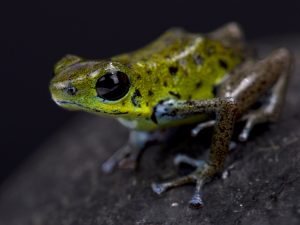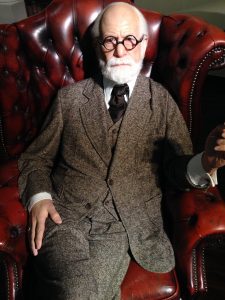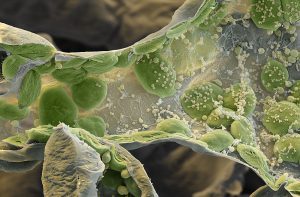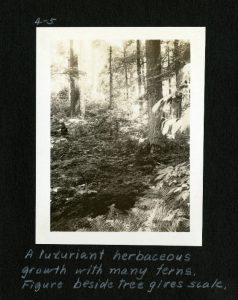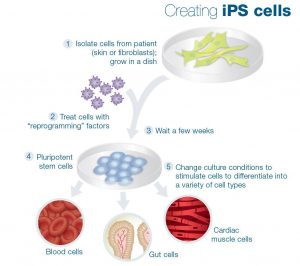by Nate Bennett
If I heard these three terms ‘out of context’, my mind would probably take a leap. Firstly, “Electric River” might be some groovy obscure band from the psychedelic era of Rock n’ Roll (which I might have discovered as a kid digging through my folks’ vinyl collections). Maybe they’d be having a reunion concert, where they’d start up as curtains emblazoned with large bubble patterns drop, or perhaps as actual soap bubbles would be blown out over the frenzied crowd. Just at showtime, however, all would be dismayed to learn that somehow, the loudspeakers were all underwater… and then the security guards would shout “sorry folks, the show’s cancelled!” (major buzz-kill). Next, all the people that had gotten together for a good time would be dispersing, disappointed.
In parts of the Illinois River, though, dispersion is the whole goal. The speakers will intentionally be subsurface, curtains of air bubbles will soon be deployed, and the river actually already is electrified. It’s all part of the efforts to make an underwater environment that is as unwelcoming as possible for the invading varieties of Asian carp that have already advanced throughout the entire Mississippi River watershed and now are threatening to enter Lake Michigan.
I recently read an article in the Chicago Tribune entitled “Asian carp have never breached a body of freshwater the size of Lake Michigan. Here’s the bizarre way they could survive and thrive in the world’s fifth largest lake.” (Briscoe, Tony). My initial assessment was that this article would describe a potential/hypothetical future situation, which of course means that any predictions that it might make can’t (yet) be evaluated directly for accuracy. The proposition made in this title, however, is based on results of a ‘modeling study’ released in August 2019 by researchers at the University of Michigan (Alsip, Peter J., et al.), which came to some startling conclusions about one species of Asian carp, the Bighead carp (Hypophthalmichthys nobilis), and it’s potential ability to feed and persist in Lake Michigan (figure 3). I have seen this study referred to repeatedly since it was published this summer; it is clearly based on valid research, and its results are worthy of being taken very seriously. That said, I do feel that this article is reliably supported, and the ‘bizarre way’ it considers is actually a very real possibility.
Several species of Asian carp were brought to the United States in the 1960’s for the purposes of cleaning farm-fishing ponds and algal blooms in water treatment facilities, but they gradually escaped into the river system and have basically taken over waterways as they have spread increasingly further upriver, into tributaries, and inched closer and closer to the Great Lakes. Now, they are within a mere few miles from Lake Michigan (Dwyer, Colin), and (so far) have been held back in the Illinois River near Chicago by several sets of underwater barriers that pulse electricity through the water to discourage and kill fish that try to pass (figures 1 and 2). It is the largest system of it’s kind in the world, but it is not seen as an infallible solution; Asian carp DNA has already been detected in Lake Michigan (Thompson, Megan et al).
Fig. 1 Fig. 2

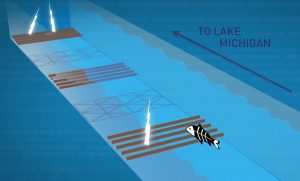 Figures 1 and 2. Thompson, Megan et al. “Midwest Battles To Keep Invasive Asian Carp Out Of The Great Lakes”. PBS Newshour, 2019, https://www.pbs.org/newshour/show/midwest-battles-to-keep-invasive-asian-carp-out-of-the-great-lakes.
Figures 1 and 2. Thompson, Megan et al. “Midwest Battles To Keep Invasive Asian Carp Out Of The Great Lakes”. PBS Newshour, 2019, https://www.pbs.org/newshour/show/midwest-battles-to-keep-invasive-asian-carp-out-of-the-great-lakes.
Whether or not Asian carp could invade and then spread through the Great Lakes has been debated. The argument has been made that the Great Lakes may not be able to support them due to the environmental impacts that have already been caused by invading species of mussels (zebra and quagga). The mussels are ‘filter feeders’ that thrive by eating microscopic plants and animals (phytoplankton and zooplankton), which are the ‘base’ of the food-chain for many aquatic animals. Asian carp also eat plankton, which would make them appear likely to be in direct competition with the mussels for food if they ever did reach the Great Lakes.
The mussels have already greatly reduced the food supply relied on by native species of small fish–causing their populations to decline rapidly. Because these small fish are an important food source relied on by larger native species of fish, populations of the larger species have also declined rapidly. Until recently, a common assumption was that the impacts caused by the mussels would also prevent the Great Lakes from being hospitable to the Asian carp.
This University of Michigan study, however, demonstrated that the Bighead carp (BHC) might not only be able to survive, but may even thrive in Lake Michigan, as it demonstrated that this species can live by consuming “fecal pellets from countless quagga and zebra mussels on the lake bottom” (Erickson, Jim).
Fig. 3
 Figure 3. Alsip, Peter J. et al. “Lake Michigan’s Suitability For Bigheaded Carp: The Importance Of Diet Flexibility And Subsurface Habitat”. Freshwater Biology, vol 64, no. 11, 2019, pp. 1921-1939. Wiley, doi:10.1111/fwb.13382.
Figure 3. Alsip, Peter J. et al. “Lake Michigan’s Suitability For Bigheaded Carp: The Importance Of Diet Flexibility And Subsurface Habitat”. Freshwater Biology, vol 64, no. 11, 2019, pp. 1921-1939. Wiley, doi:10.1111/fwb.13382.
This diagram, from the UofM study, shows three different ‘habitat suitability’ scenarios in Lake Michigan for the BHC (grey areas are considered unsuitable, blue areas are possibly suitable, and red areas are considered highly likely to be able to support the species). In the ‘best case’ (diagram on left), the BHC could live only in some areas of the lake, and possibly only during warm times of the year. In the ‘worst case’ (right diagram), they could live throughout most of the lake—and possibly year-round.
As strange as it may seem, it appears from the study that the mussels may actually provide a food source that BHC could rely on with minimal effort, which might even provide the species with optimal foraging. If this is in fact the case, the BHC would conceivably be fit to thrive and reproduce rapidly in the Great Lakes, enabled by the vast populations of invading mussels and the waste that they produce. Even if the fish could not survive throughout the year, the mussels could enable the carp to survive well enough during warm times to migrate to the areas where they could survive full-time, including other tributaries that reach the lakes.
Now, renewed effort is being put into building more electrical barriers, as well as adding curtains of bubbles and even blasting sounds through underwater loudspeakers to prevent Asian carp from reaching the Great Lakes.
According to the Chicago Tribune article, the Army Corps of Engineers has been authorized to move forward with preconstruction of more Asian carp deterrents at another location near Joliet Illinois, which will include another electric fence, a bubble barrier/curtain, and underwater loudspeakers. The project is expected to cost about $831 million and is expected to be completed in 2028.
Multiple states in the Great Lakes area and two Canadian provinces are ‘discussing’ cost-sharing. Hopefully, these discussions and all the construction that is planned won’t drag on too long… the Asian carp are already within a mere few miles of Lake Michigan. Hopefully, it isn’t already too late to prevent the impending invasion.
Either way, it’s all going to be a lot less fun than a far-out reunion concert would be, even if the band didn’t end up sounding quite as good as they did on their classic album.
Works Cited
Briscoe, Tony. “Chicago Tribune – Asian Carp Have Never Breached A Body Of Freshwater The Size Of Lake Michigan. Here’s The Bizarre Way They Could Survive And Thrive In The World’s Fifth Largest Lake.”. Chicagotribune.Com, 2019, https://www.chicagotribune.com/news/environment/ct-met-lake-michigan-asian-carp-study-20190812-nwanxjkymjcvteooe6ymumrroi-story.html. Accessed 1 Nov 2019.
Dwyer, Colin. “NPR Choice Page”. Npr.Org, 2019, https://www.npr.org/sections/thetwo-way/2017/06/23/534105477/invasive-carp-caught-9-miles-from-great-lakes-in-cause-for-serious-concern. Accessed 3 Nov 2019.
Erickson, Jim. “U-M Study: Asian Carp Capable Of Surviving In Much Larger Areas Of Lake Michigan Than Previously Thought”. University Of Michigan News, 2019, https://news.umich.edu/asian-carp-capable-of-surviving-in-much-larger-areas-of-lake-michigan-than-previously-thought/. Accessed 3 Nov 2019.
Thompson, Megan et al. “Midwest Battles To Keep Invasive Asian Carp Out Of The Great Lakes”. PBS Newshour, 2019, https://www.pbs.org/newshour/show/midwest-battles-to-keep-invasive-asian-carp-out-of-the-great-lakes. Accessed 3 Nov 2019.
